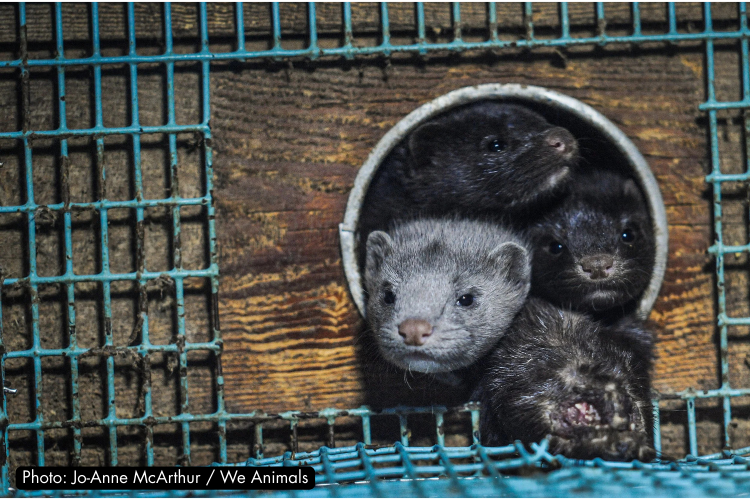Roadside zoos are animal welfare disasters
Credit: Andrew Skowron/Open Cages
Kangaroos and wallabies confined to tiny pens, with sores on their body. Tigers left without proper heating in sub-zero temperatures. Bears kept in concrete pits with no resemblance to their natural habitat. Alligators fighting for food in crowded enclosures, later having their mouths taped shut so visitors can interact with them. These are just a few examples of the animal welfare disasters documented by PETA at roadside zoos.
Roadside zoos are a welfare nightmare for animals. They are typically small zoos where wild animals are confined in small cages and frequently forced to interact with visitors in stressful and unnatural ways. Despite their name these “zoos” are not accredited by the American Zoological Association (AZA), which means they do not need to adhere to the same elevated requirements on space and treatment of animals. According to an article from the Journal of Corporate Law, there are around 2800 zoos licensed by the USDA and only 237 of these are accredited by the AZA.
The lower requirements of the USDA mean that roadside zoos are frequently rife with animal welfare problems, including unsanitary conditions, poor veterinary care, and small enclosures. Maya Sanaba explains that “these squalid conditions are prevalent because USDA licensing requirements are drastically less strict than the standards which AZA-accredited zoos must achieve” (p.416).
While the AZA has species-specific standards that must be met in order to remain compliant, the USDA only requires broad compliance with the Animal Welfare Act. This means that some animals, such as reptiles and amphibians, receive essentially no protection as these species are not protected under the Animal Welfare Act. Even when animals are covered by the Animal Welfare Act, the “protections” are abysmal. The act itself is vague, stating that “Enclosures shall be constructed and maintained so as to provide sufficient space to allow each animal to make normal postural and social adjustments with adequate freedom of movement.” What this translates to in practice is very small and inhumane enclosures. For example, the largest nonhuman primates (over 55 pounds), enclosures must be a minimum of 25.1 square feet, or the equivalent of a 5’ x 5’ room, smaller than the average bathroom. With other species, Carney Anne Nasser, Esq. notes that the vague Animal Welfare Act space requirements “are left undefined, and in many cases amount to ‘broadly-worded guidance’ which inspectors have ‘difficulty interpreting’.” According to a study published in the journal Zoology, lions in Botswana can have a range of 1131-4314 square kilometers. Lion enclosures at roadside zoos are usually not even close to 1% of this size.
USDA standards for roadside zoos are low, but even still many roadside zoos are found in violation of these standards year after year. Despite these violations, the USDA has reissued licenses for roadside uses to continue to operate.
The negative impacts of roadside zoo conditions on animals show up in animal behavior in what is called “zoochosis”. Zoochosis are pointless, unnatural behaviors that are usually repeated over and over by animals living in stressful conditions often present in roadside zoos. Examples include “head rolling, striding, extreme licking, hair, or feather pulling, pacing, and playing with food items, unsuitable socio-sexual conduct, and outline swimming”. These are all signs that an animal’s mental health is suffering.
In nature, animals like to keep their distance from other animals - especially predators. Being placed in close proximity to other animals, including humans, is a very stressful experience for them. This is an issue even at AZA accredited zoos, and this stress is likely even higher in roadside zoos where sometimes animals are not just forced to be close to humans but to be touched and held by them.
Besides the harms to animals in zoos, roadside zoos help fuel breeding of animals in captivity, including breeding hybrid species. Breeding hybrid animals does nothing for conservation, and being bred in captivity these animals could not be released into the wild even if roadside zoos were shut down.
Roadside zoos are pernicious because they don’t usually call themselves roadside zoos. Rather, they adopt labels like “sanctuary” or “refuge” and portray themselves as being focused on conservation and education. By using these titles, roadside zoos mask their true negative impact on animals and pull in guests who otherwise wouldn’t visit. Some red flags that a “sanctuary” may be a roadside zoo more interested in money than conservation or animal welfare are:
Small and cramped enclosures.
Enclosures that force animals to be close or face-to-face with humans.
Events that allow visitors to touch or directly interact with the animals.
Animals exhibiting signs of zoochosis.
Despite their problems, roadside zoos can be tempting. One of the seeming contradictions with roadside zoos is that the people who visit them typically do so because they love animals, yet by attending these zoos they contribute to inhumane treatment of animals (a phenomenon I call the Lennie Small Paradox). But as enticing as close encounters with animals can be, visiting roadside zoos is not ethical. World Animal Protection suggests five alternatives to visiting roadside zoos:
Visiting wildlife sanctuaries or rescue centers (that are actually sanctuaries and not roadside zoos in disguise).
Taking a safari or wildlife tour.
Supporting conservation organizations.
Watching documentaries or educational videos.
Visiting botanical gardens and nature reserves.
One of the worst examples of these exploitative attractions is the Cherokee Bear Zoo in Cherokee, North Carolina. Please join Species Unite in calling on the USDA and Cherokee Tribal Council to shut down this attraction. Take action here.
Written by Michael Briscoe
Michael Briscoe is an Assistant Professor of Sociology at Colorado State University Pueblo. He is the author of the book Stocks or Stakeholders: The Benefits of Considering Animal Interests. His research and teaching focus on the interconnections of human, animal, and environmental well-being.
Want to write for Species Unite? We are looking for well-written stories focusing on content that informs, inspires, and engages our audience with topics surrounding animal rights.
We Have A Favor To Ask…
Species Unite amplifies well-researched solutions to some of the most abusive animal industries operating today.
At this crucial moment, with worldwide momentum for change building, it’s vital we share these animal-free solutions with the world - and we need your help.
We’re a nonprofit, and so to keep sharing these solutions, we’re relying on you - with your support, we can continue our essential work in growing a powerful community of animal advocates this year.









